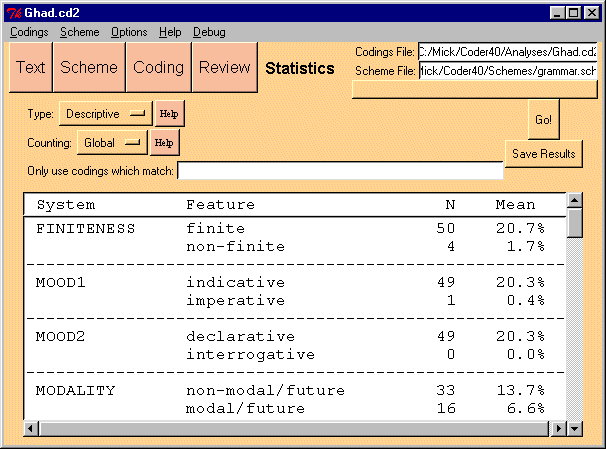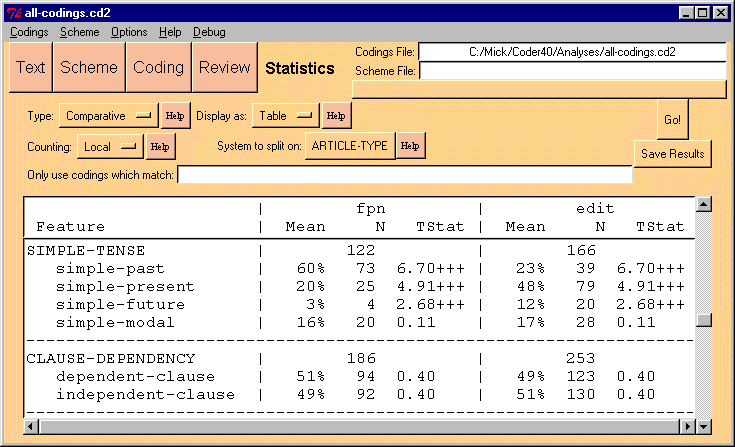8. Statistics
The Coder allows some basic statistics to be performed, mainly descriptive
statistics (reporting the means, etc., of each feature), and comparative
statistics (splitting the codings into two or more sets, and reporting
significant differences between these sets).
8.1 Descriptive Statistics
Selecting "Descriptive" in the Type field, and pressing the Go button
will show the counts and mean value for each feature. You can also specify
a filter to apply first, allowing you to get counts on subsets of the corpus.
Filters are specified as in the Review section.

Figure 8: Descriptive Statistics
8.1.1 Local/Global Counting
This widget allows you to choose between two ways of deriving the mean:
-
Global Mean: The global mean represents the likelihood of selection
in the corpus as a whole. It is derived by dividing the number of
times the feature occurs in the codings by the total number of codings.
-
Local Mean: the local mean represents the likelihood of choice within
a system. It is derived by diving the total number of codings with this
feature by the total number of codings which select from the same system.
Thus, the sum of means for all features in a system is always 100%.
The user can choose between these two modes using the popup menu on the
interface.
8.1.2 Save Results
Pressing the Save Results button saves the results as plain text,
or alternatively as an HTML file. This HTML file can be opened into MS
Word as a way of getting the results into a report. For an example of results
saved in HTML (using "Comparative: system-by-system) click here.
8.1.2 Exporting Data to Statistical Packages
For more detailed statistical analysis, the codings can be exported in
a form (tab-delimited) which statistical packages can import. Choose "Save
Codings As..." from the Codings menu, and change the File Type field to
"Tab Delimited". The codings thus saved can be loaded in some statistical
packages for more detailed analysis.
8.2 Comparative Statistics
You can split your codings into two or more subsets and compare
these subsets compare statistically. Choose "Comparative" in the Type field
to start. See figure 8.

Figure 8: The Comparative Statistics Display
8.2.1 Setting up the Study
Selecting the Split System: You split your data on the basis of
the features in a system. For instance, if you have a system: modal/nonmodal,
then select this system in the "System to Split on" popup menu. The data
will be split into two sets: codings with feature modal and codings
with feature nonmodal.
Note: if you only wish to compare 2 features in a system with 2 or more
features, use the following method.
i) Save your codings. ii) Go to the Scheme interface and delete
the
feature(s) you don't want in the comparison.
iii) Come back and do the statistical study. DO NOT SAVE THE CODINGS
WITH THE DELETED FEATURE(S).
Filtering Data: You can use the filter to select only subsets
of your data. For instance, you might wish to compare only finite-clauses.
See the Review section for details.
Excluding Systems from the Comparison: if you don't want the
comparison to include details on particular systems, you can i) return
to the Scheme interface; ii) click on systems you want excluded iii) select
"Ignore System". These systems will then be ignored in the statistical
results.
Presentation in Table or Individual Systems: Using the "Display
as" popup menu, you can choose to display the results as a table (see figure
8), or viewing an interpretation of the results system by system. Figure
9 shows the system-by-system method of presentation (actually from the
results saved to html). Note that the Coder is here starting to write your
report for you, doing some basic interpretation.
Note: Currently,
system-by-system comparisons are only available for systems with two features.
If you wish to compare between two features in a system with more features,
use the Scheme interface to delete the excess features (BUT DON'T SAVE
AFTERWARDS), then do the study.
System: REALIS
| Feature |
fpn(N=132) |
edit(N=189) |
|
| |
Mean |
Stddv |
Mean |
Stddv |
Tstat |
Lvl |
| realis |
0.720 |
0.451 |
0.598 |
0.492 |
2.259 |
++ |
| irrealis |
0.280 |
0.451 |
0.402 |
0.492 |
2.259 |
++ |
Interpretation
-
Set1 (fpn) exhibits significantly higher use of the feature: realis
(72.00% vs. 59.80%).
-
Set2 (edit) exhibits significantly higher use of the feature: irrealis
(40.20% vs. 28.00%).
Figure 9: System-by-System interpretation of comparison
Local vs. Global Counting: See Descriptive Statistics for the
difference between these two ways of calculating means. In the context
of comparative studies, you can choose to use local or global means as
the basis of comparison.
Doing the Study: Once you have set all the options, press the
"Go" button to have the study presented.
Saving the Study: Hit the "Save Results" button to save the study
as either plain text or html.
8.2.2 Interpreting the Results: Significance & T-Statistics
The Table-mode presentation includes one column for each feature.
The column provides the mean occurrence of the feature, the count of occurrences,
and some information regarding how different this result is that for the
other features.
The difference between means is shown in terms of two indicators:
Level of Significance: Firstly, at the end of the entry there
will be between 0 and 3 "+" signs. These indicate how statistically significant
is the difference of this features mean from that of the mean of all the
other data put together:
(none) Not significantly different.
+ Significant at the 90% level (10% chance of error).
++ Significant at the 95% level (5% chance of error).
+++ Significant at the 98% level (2% chance of error).
The level of significance is important to establish how repeatable your
results are. Results without significance may be accidents, and if we repeat
the study with other texts, they might not be repeated. If results are
highly significant they are likely to be repeatable if we apply the analysis
to a totally different pair of texts. To understand this, a single
+ means that of any 10 results with one plus, you can expect one to be
a false result (10% chance of error).
T-Statistic: T-Stats are the numbers on which the level
of significance is derived. The bigger it is, the higher the level of significance,
but this also depends on how much data you have. In some more scientific
papers, you might be requested to provide T-Stats, but it is quite rare
in linguistics. See textbooks on Statistics for more detail.
The System-By-System display also displays the standard deviation
of each mean. This statistic tells you how much variation there is in your
data. For more detail, see: see:
http://www.robertniles.com/stats/stdev.shtml).
8.3 Comparing Two Files
You might wish to code two distinct texts using the same network, and then
compare how they differ in their use of the systems. For instance, we might
code an essay by a ten year old and one by a twelve year old and compare,
or a corpus for Spanish and one for English. The Coder allows you to compare
two files with the same network/scheme. To do this:
1. Ensure the two files use the same scheme when coding: As we have
been working up to now, each file of codings has been saved with the coding
scheme embedded in the file. The codings and the scheme are both in one
file. However, another way of working is to have the scheme in a different
file to the coding file. This means that several text files can share the
same scheme. I call an external scheme a master scheme.
-
To convert from using a codings file with the scheme embedded to using
an external master scheme: a) Open the Codings file. b) Under the Options
menu, choose Save Options… c) In the presented window, choose Save to Master.
d) Then press the Locate button in this window, and type in a filename
for the new master scheme. Hit the OK button to return to the previous
window, and press Done here.
-
The Codings file now requires this master scheme to be present whenever
it is used. If you move it, the Coder will ask you to locate it.
-
When you Import Text to start a second codings file, you normally select
"Start from Scratch" and build your own network afresh. This time, select
"Use Master", and select the newly created Master scheme. You will then
have to segment the new text, but you will have a scheme present already.
So, after segmentation, you can move directly to coding.
-
Finish coding this second file, and save it to disk. If you change the
network during this coding, you might want to re-open the first file, and
update the codings to ensure that the changed network is ok for this file
as well. In the Codings section, go to the first coding, and then press
"Next Incomplete" to see if any need to be added to.
2. Open one of the files in the Coder.
3. Go to the Statistics interface, and select "Compare Files" from the
menu which normally shows "Descriptive".
4. A new item appears on the screen, asking you to provide the filename
to compare to: hit the Locate button and select another file which uses
the same scheme.
5. Hit the Go button and the results should be shown.
8.4 Cell Analysis
This simple form of Cell Analysis finds all codings which have exactly
the same features assigned to them. This is a useful tool to identify the
recurrent patterns in your corpus. Select "Cell Analysis" from the "Type:"
menu, and then press the "Go" button. The display will show each grouping,
sorted by size.
For each group, it shows the features common to the group, and an example,
the number of codings in the group, and the members of the group.
You can use "Ignore systems" in the Scheme window to reduce the number
of systems used for cell grouping. Remove systems which are more delicate, or perhaps irrelevant for grouping.

